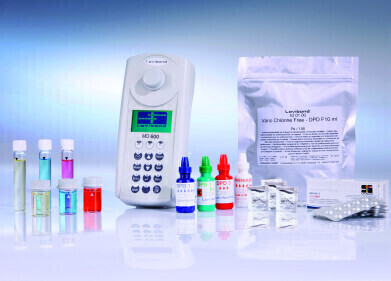-
 An Ocean Insight QE Pro spectrometer is at heart of this instrument for monitoring chlorophyll fluorescence, which helps users better understand vegetation health and carbon uptake. Photo courtesy JB Hyperspectral.
An Ocean Insight QE Pro spectrometer is at heart of this instrument for monitoring chlorophyll fluorescence, which helps users better understand vegetation health and carbon uptake. Photo courtesy JB Hyperspectral.
Portable/Field Testing
Using spectroscopy to monitor and preserve the environment
Nov 20 2020
With challenges from population growth to climate change, environmental researchers, government regulators, and industrial businesses need tools to help manage the world’s natural resources. Ocean Insight provides customers with the spectral products, application knowledge, and technical expertise to monitor environmental elements including air, water, soil and vegetation.
As spectrometers have become faster, smaller and more powerful, researchers and regulators can deploy instruments almost anywhere for real-time, in situ monitoring. That’s a significant advance from earlier generations of instruments that required extracting samples from the field and bringing them back to the lab for analysis.
Ocean Insight work with environmental sensor suppliers such as Danfoss IXA and JB Hyperspectral that have made spectrometer-based systems rugged and reliable enough for long-term operation in the field. “We like the flexibility of Ocean Insight spectrometers,” said Tommaso Julitta, managing director of JB Hyperspectral. “For example, for fluorescence, we can specify the specific mirror, grating or spectral range. We have integrated into our products four or five different types of spectrometers, which are already running smoothly.”
By some estimates, 2% of global emissions come from shipping, even with ongoing efforts to improve ship operation and growing awareness of factors affecting climate change.
Fibre optic spectrometers are among the optical sensing tools that sensor developers and ship operators are using to address exhaust emission measurements. In addition to the real-time measurements they provide, these spectrometers can be integrated into marine sensors to monitor exhaust parameters more cost effectively and with greater flexibility.
Danfoss IXA, which provides sensors for the maritime industry, worked with Ocean Insight to develop an emission sensor using spectroscopy for continuous measurements of common air pollutants including NOx, SO2 and NH3. This system has been adapted to withstand harsh marine conditions and ensure minimal maintenance during lengthy voyages.
“We identified an opportunity for emission measurements that would help ship operators overcome many of the challenges related to existing solutions,” said Finn Haugaard, Supply Chain Manager for Danfoss IXA. “To choose spectroscopy was a rather easy choice, as the technology had already proven to be effective in measuring, for example, sulphur, ammonia and various NOx gases.”
From open-path air monitoring to remote sensing of forest canopies, Ocean Insight offers a range of solutions for environmental sensor integrators and end users. Customers can use spectroscopy and multispectral imaging-based tools to analyze climate trends and make businesses smarter, more efficient and fully compliant with regulatory standards.
“Forests, crops, freshwaters, snow, glaciers and the atmosphere are environmental elements playing a significant role in climate,” said Andreas Burkart, head of R&D for JB Hyperspectral. “Monitoring them helps us to have a comprehensive picture of natural processes and hopefully, will make us aware of the actions we need to take to preserve our planet.”
For example, JB has a customer that uses its RoX instrument to measure the properties of snow. RoX is a self-contained, continuous monitoring system that uses an Ocean Insight Flame spectrometer (300-950 nm) for long-term measurements of solar radiance, reflected radiance and reflectance. If algae or particulates including dust and black carbon cover the snow, more sunlight is absorbed and the melting process speeds up. “This is interesting because, in principle,” said Julitta, “if the snowmelt is faster, then the water availability at the end [of the process] could be changing.”
Additional optical spectroscopy techniques are used for environmental analysis. For example, researchers have created fluorescence assays to measure the concentration of mercury in water, soil and fish. By using nanomaterials to create these high sensitivity assays, the researchers can use a modular fluorescence spectroscopy system for their measurements. The entire system fits into a small case and operates using battery power and a laptop computer.
Raman spectroscopy is another versatile technique, using information about vibrational and rotational transitions in molecules to extract detailed chemical analysis of solids, liquids and gases. Although more often associated with life sciences and materials analysis, Raman has been tested for environmental applications including deep-sea analysis of geochemical characteristics. The goal is to use this data to monitor geological formations and processes for better understanding of the ocean floor.
With the diversity of options and degree of sophistication of optical sensing technologies continuing to expand, researchers, regulators and environmental scientists have a comprehensive toolkit of highly accessible analytical instruments to meet their needs.
Digital Edition
AET 28.2 April/May 2024
May 2024
Business News - Teledyne Marine expands with the acquisition of Valeport - Signal partners with gas analysis experts in Korea Air Monitoring - Continuous Fine Particulate Emission Monitor...
View all digital editions
Events
Jul 30 2024 Jakarta, Indonesia
China Energy Summit & Exhibition
Jul 31 2024 Beijing, China
2024 Beijing International Coal & Mining Exhibition
Aug 07 2024 Beijing, China
IWA World Water Congress & Exhibition
Aug 11 2024 Toronto, Canada
Aug 25 2024 Stockholm, Sweden and online









.jpg)








